Highly Efficient Layer-by-Layer Organic Photovoltaics Enabled by Additive Strategy
Abstract
:1. Introduction
2. Materials and Methods
2.1. Materials
2.2. Device Fabrication
2.3. Characterization
3. Results
4. Conclusions
Supplementary Materials
Author Contributions
Funding
Data Availability Statement
Conflicts of Interest
References
- Guo, Y.; Li, D.; Gao, Y.; Li, C. Recent Progress on Stability of Organic Solar Cells Based on Non-Fullerene Acceptors. Acta Phys. Chim. Sin. 2023, 40, 2306050. [Google Scholar] [CrossRef]
- Jee, M.; Ryu, H.; Lee, D.; Lee, W.; Woo, H. Recent Advances in Nonfullerene Acceptor-Based Layer-by-Layer Organic Solar Cells Using a Solution Process. Adv. Sci. 2022, 9, 2201876. [Google Scholar] [CrossRef]
- Li, Y.; Huang, W.; Zhao, D.; Wang, L.; Jiao, Z.; Huang, Q.; Wang, P.; Sun, M.; Yuan, G. Recent Progress in Organic Solar Cells: A Review on Materials from Acceptor to Donor. Molecules 2022, 27, 1800. [Google Scholar] [CrossRef] [PubMed]
- Yang, B.; Zhang, C.; Wang, Y.; Zhang, M.; Liu, Z.; Wu, Y.; Chen, H. Theoretical study on organic photovoltaic heterojunction FTAZ/IDCIC. Chin. J. Chem. Phys. 2023, 36, 199–210. [Google Scholar] [CrossRef]
- Xu, X.; Li, Y.; Peng, Q. Ternary Blend Organic Solar Cells: Understanding the Morphology from Recent Progress. Adv. Mater. 2022, 34, 2107476. [Google Scholar] [CrossRef]
- Inganäs, O. Organic Photovoltaics over Three Decades. Adv. Mater. 2018, 30, 1800388. [Google Scholar] [CrossRef]
- Zhou, M.; Liao, C.; Duan, Y.; Xu, X.; Yu, L.; Li, R.; Peng, Q. 19.10% Efficiency and 80.5% Fill Factor Layer-by-Layer Organic Solar Cells Realized by 4-Bis (2-Thienyl) Pyrrole-2,5-Dione Based Polymer Additives for Inducing Vertical Segregation Morphology. Adv. Mater. 2023, 35, 2208279. [Google Scholar] [CrossRef]
- Ning, H.; Jiang, Q.; Han, P.; Lin, M.; Zhang, G.; Chen, J.; Chen, H.; Zeng, S.; Gao, J.; Liu, J.; et al. Manipulating the solubility properties of polymer donors for high-performance layer-by-layer processed organic solar cells. Energy Environ. Sci. 2021, 14, 5919–5928. [Google Scholar] [CrossRef]
- Hu, M.; Zhang, Y.; Liu, X.; Zhao, X.; Hu, Y.; Yang, Z.; Yang, C.; Yuan, Z.; Chen, Y. Layer-by-Layer Solution-Processed Organic Solar Cells with Perylene Diimides as Acceptors. ACS Appl. Mater. Interfaces 2021, 13, 29876–29884. [Google Scholar] [CrossRef]
- Wei, Y.; Chen, Z.; Lu, G.; Yu, N.; Li, C.; Gao, J.; Gu, X.; Hao, X.; Lu, G.; Tang, Z.; et al. Binary Organic Solar Cells Breaking 19% via Manipulating the Vertical Component Distribution. Adv. Mater. 2022, 34, 2204718. [Google Scholar] [CrossRef]
- Sun, R.; Guo, J.; Sun, C.; Wang, T.; Luo, Z.; Zhang, Z.; Jiao, X.; Tang, W.; Yang, C.; Li, Y.; et al. A universal layer-by-layer solution-processing approach for efficient non-fullerene organic solar cells. Energy Environ. Sci. 2019, 12, 384–395. [Google Scholar] [CrossRef]
- Liu, M.; Yao, Q.; Li, S.; Qin, Y.; Jeong, S.Y.; Ma, Y.; Shen, L.; Ma, X.; Yang, K.; Yuan, G.; et al. Interfacial Engineering for Photomultiplication Type Organic Photodetectors with Signal-Noise-Ratio over 89,000. Adv. Opt. Mater. 2024, 12, 2303216. [Google Scholar] [CrossRef]
- Hong, L.; Yao, H.; Cui, Y.; Bi, P.; Zhang, T.; Cheng, Y.; Zu, Y.; Qin, J.; Yu, R.; Ge, Z.; et al. 18.5% Efficiency Organic Solar Cells with a Hybrid Planar/Bulk Heterojunction. Adv. Mater. 2021, 33, 2103091. [Google Scholar] [CrossRef] [PubMed]
- Xu, W.; Tian, H.; Ni, Y.; Xu, Y.; Zhang, L.; Zhang, F.; Wu, S.; Jeong, S.; Huang, T.; Du, X.; et al. Eco-friendly solvent-processed layer-by-layer ternary all-polymer solar cells exhibiting over 18.5% efficiency. Chem. Eng. J. 2024, 493, 152558. [Google Scholar] [CrossRef]
- Ma, X.; Xu, W.; Liu, Z.; Jeong, S.; Xu, C.; Zhang, J.; Woo, H.; Zhou, Z.; Zhang, F. Over 18.1% Efficiency of Layer-by-Layer Polymer Solar Cells by Enhancing Exciton Utilization near the ITO Electrode. ACS Appl. Mater. Interfaces 2023, 15, 7247–7254. [Google Scholar] [CrossRef]
- Tian, H.; Xu, W.; Liu, Z.; Xie, Y.; Zhang, W.; Xu, Y.; Jeong, S.; Zhang, F.; Weng, N.; Zhang, Z.; et al. Over 18.8% Efficiency of Layer-By-Layer Organic Photovoltaics Enabled by Ameliorating Exciton Utilization in Acceptor Layer. Adv. Funct. Mater. 2024, 34, 2313751. [Google Scholar] [CrossRef]
- Zhang, L.; Zhang, M.; Ni, Y.; Xu, W.; Zhou, H.; Ke, S.; Tian, H.; Jeong, S.; Wong, W.; Ma, X.; et al. Over 17.1% or 18.2% Efficiency of Layer-by-Layer All-Polymer Solar Cells via Incorporating Efficient Pt Complexes as Energy Donor Additive. ACS Mater. Lett. 2024, 6, 2964–2973. [Google Scholar] [CrossRef]
- Chen, Q.; Huang, H.; Hu, D.; Zhang, C.; Xu, X.; Lu, H.; Wu, Y.; Yang, C.; Bo, Z. Improving the Performance of Layer-by-Layer Processed Organic Solar Cells via Introducing a Wide-Bandgap Dopant into the Upper Acceptor Layer. Adv. Mater. 2023, 35, 2211372. [Google Scholar] [CrossRef]
- Chen, T.; Li, S.; Li, Y.; Chen, Z.; Wu, H.; Lin, Y.; Gao, Y.; Wang, M.; Ding, G.; Min, J.; et al. Compromising Charge Generation and Recombination of Organic Photovoltaics with Mixed Diluent Strategy for Certified 19.4% Efficiency. Adv. Mater. 2023, 35, 2300400. [Google Scholar] [CrossRef]
- Li, C.; Gu, X.; Chen, Z.; Han, X.; Yu, N.; Wei, Y.; Gao, J.; Chen, H.; Zhang, M.; Wang, A.; et al. Achieving Record-Efficiency Organic Solar Cells upon Tuning the Conformation of Solid Additives. J. Am. Chem. Soc. 2022, 144, 14731–14739. [Google Scholar] [CrossRef]
- Liu, K.; Jiang, Y.; Liu, F.; Ran, G.; Huang, F.; Wang, W.; Zhang, W.; Zhang, C.; Hou, J.; Zhu, X. Organic Solar Cells with Over 19% Efficiency Enabled by a 2D-Conjugated Non-fullerene Acceptor Featuring Favorable Electronic and Aggregation Structures. Adv. Mater. 2023, 35, 2300363. [Google Scholar] [CrossRef] [PubMed]
- Sun, R.; Wu, Q.; Guo, J.; Wang, T.; Wu, Y.; Qiu, B.; Luo, Z.; Yang, W.; Hu, Z.; Guo, J.; et al. A Layer-by-Layer Architecture for Printable Organic Solar Cells Overcoming the Scaling Lag of Module Efficiency. Joule 2020, 4, 407–419. [Google Scholar] [CrossRef]
- Ding, G.; Chen, T.; Wang, M.; Xia, X.; He, C.; Zheng, X.; Li, Y.; Zhou, D.; Lu, X.; Zuo, L.; et al. Solid Additive-Assisted Layer-by-Layer Processing for 19% Efficiency Binary Organic Solar Cells. Nano Micro Lett. 2023, 15, 92. [Google Scholar] [CrossRef] [PubMed]
- Tian, H.; Ni, Y.; Zhang, W.; Xu, Y.; Zheng, B.; Jeong, S.; Wu, S.; Ma, Z.; Du, X.; Hao, X.; et al. Over 19.2% efficiency of layer-by-layer organic photovoltaics enabled by a highly crystalline material as an energy donor and nucleating agent. Energy Environ. Sci. 2024, 17, 5173–5182. [Google Scholar] [CrossRef]
- Wang, M.; Yang, L.; Xu, X.; Qin, W.; Yin, S. Improved efficiency of flexible polymer solar cells with a non-annealing active layer. J. Renew. Sustain. Energy 2014, 6, 023128. [Google Scholar] [CrossRef]
- Fu, H.; Peng, Z.; Fan, Q.; Lin, F.R.; Qi, F.; Ran, Y.; Wu, Z.; Fan, B.; Jiang, K.; Woo, H.Y.; et al. A Top-Down Strategy to Engineer Active Layer Morphology for Highly Efficient and Stable All-Polymer Solar Cells. Adv. Mater. 2022, 34, 2202608. [Google Scholar] [CrossRef] [PubMed]
- Li, C.; Zhou, J.; Song, J.; Xu, J.; Zhang, H.; Zhang, X.; Guo, J.; Zhu, L.; Wei, D.; Han, G.; et al. Non-fullerene acceptors with branched side chains and improved molecular packing to exceed 18% efficiency in organic solar cells. Nat. Energy 2021, 6, 605–613. [Google Scholar] [CrossRef]
- Gurney, R.; Lidzey, D.; Wang, T. A review of non-fullerene polymer solar cells: From device physics to morphology control. Rep. Prog. Phys. 2019, 82, 036601. [Google Scholar] [CrossRef]
- Liu, W.; Sun, S.; Zhou, L.; Cui, Y.; Zhang, W.; Hou, J.; Liu, F.; Xu, S.; Zhu, X. Design of Near-Infrared Nonfullerene Acceptor with Ultralow Nonradiative Voltage Loss for High-Performance Semitransparent Ternary Organic Solar Cells. Angew. Chem. Int. Edit. 2022, 61, e202116111. [Google Scholar] [CrossRef]
- Firdaus, Y.; Le Corre, V.; Karuthedath, S.; Liu, W.; Markina, A.; Huang, W.; Chattopadhyay, S.; Nahid, M.; Nugraha, M.; Lin, Y.; et al. Long-range exciton diffusion in molecular non-fullerene acceptors. Nat. Commun. 2020, 11, 5220. [Google Scholar] [CrossRef]
- Li, X.; Yang, H.; Du, X.; Lin, H.; Yang, G.; Zheng, C.; Tao, S. High-Performance Layer-by-Layer organic solar cells enabled by Non-Halogenated solvent with 17.89% efficiency. Chem. Eng. J. 2023, 452, 139496. [Google Scholar] [CrossRef]
- Liu, F.; Zhou, L.; Liu, W.; Zhou, Z.; Yue, Q.; Zheng, W.; Sun, R.; Liu, W.; Xu, S.; Fan, H.; et al. Organic Solar Cells with 18% Efficiency Enabled by an Alloy Acceptor: A Two-in-One Strategy. Adv. Mater. 2021, 33, 2100830. [Google Scholar] [CrossRef]
- Fu, J.; Fong, P.; Liu, H.; Huang, C.; Lu, X.; Lu, S.; Abdelsamie, M.; Kodalle, T.; Sutter-Fella, C.; Yang, Y.; et al. 19.31% binary organic solar cell and low non-radiative recombination enabled by non-monotonic intermediate state transition. Nat. Commun. 2023, 14, 1760. [Google Scholar] [CrossRef]
- Chen, H.; Jeong, S.; Tian, J.; Zhang, Y.; Naphade, D.; Alsufyani, M.; Zhang, W.; Griggs, S.; Hu, H.; Barlow, S.; et al. A 19% efficient and stable organic photovoltaic device enabled by a guest nonfullerene acceptor with fibril-like morphology. Energy Environ. Sci. 2023, 16, 1062–1070. [Google Scholar] [CrossRef]
- Yang, Y.; Feng, E.; Li, H.; Shen, Z.; Liu, W.; Guo, J.; Luo, Q.; Zhang, J.; Lu, G.; Ma, C.; et al. Layer-by-layer slot-die coated high-efficiency organic solar cells processed using twin boiling point solvents under ambient condition. Nano Res. 2021, 14, 4236–4242. [Google Scholar] [CrossRef]
- Cui, Y.; Yao, H.; Hong, L.; Zhang, T.; Xu, Y.; Xian, K.; Gao, B.; Qin, J.; Zhang, J.; Wei, Z.; et al. Achieving Over 15% Efficiency in Organic Photovoltaic Cells via Copolymer Design. Adv. Mater. 2019, 31, 1808356. [Google Scholar] [CrossRef] [PubMed]
- Wang, X.; Zhang, L.; Hu, L.; Xie, Z.; Mao, H.; Tan, L.; Zhang, Y.; Chen, Y. High-Efficiency (16.93%) Pseudo-Planar Heterojunction Organic Solar Cells Enabled by Binary Additives Strategy. Adv. Funct. Mater. 2021, 31, 2102291. [Google Scholar] [CrossRef]
- Sun, R.; Wu, Y.; Yang, X.; Gao, Y.; Chen, Z.; Li, K.; Qiao, J.; Wang, T.; Guo, J.; Liu, C.; et al. Single-Junction Organic Solar Cells with 19.17% Efficiency Enabled by Introducing One Asymmetric Guest Acceptor. Adv. Mater. 2022, 34, 2110147. [Google Scholar] [CrossRef] [PubMed]
- Xu, W.; Zhang, M.; Liu, Z.; Tian, H.; Zhang, W.; Sun, S.; Jeong, S.; Zhang, F.; Li, X.; Sun, Q.; et al. A nonfullerene acceptor as a solid additive realizing a record efficiency of 17.74% in quasi-layered all-polymer solar cells. J. Mater. Chem. A 2024, 12, 4077–4085. [Google Scholar] [CrossRef]
- Kaewprajak, A.; Kumnorkaew, P.; Sagawa, T. Influence of binary additives into the solvent for preparation of polymer and fullerene bulk heterojunction solar cells by convective deposition method. Org. Electron. 2019, 73, 18–25. [Google Scholar] [CrossRef]
- Zhao, X.; Liu, M.; Wang, J.; Yang, K.; Zhang, H.; Jeong, S.; Ma, X.; Woo, H.; Zhang, F. Dual-Band Photomultiplication-Type Organic Photodetectors with Ultrahigh Signal-to-Noise Ratios. ACS Appl. Mater. Interfaces 2024, 16, 35400–35409. [Google Scholar] [CrossRef] [PubMed]
- Zhu, Y.; Wang, K.; Zheng, S.; Wang, H.; Dong, J.; Li, J. Application and Development of Electrochemical Spectroscopy Methods. Acta Phys. Chim. Sin. 2023, 40, 2304040. [Google Scholar] [CrossRef]
- Zhao, X.; Li, X.; Liu, M.; Zhao, Z.; Yang, K.; Liu, P.; Zhang, H.; Li, J.; Ma, X.; Yao, Q.; et al. Photomultiplication-Type All-Polymer Photodetectors and Their Applications in Photoplethysmography Sensor. Acta Phys. Chim. Sin. 2024, 40, 2311021. [Google Scholar] [CrossRef]
- Sun, Y.; Nian, L.; Kan, Y.; Ren, Y.; Chen, Z.; Zhu, L.; Zhang, M.; Yin, H.; Xu, H.; Li, J.; et al. Rational control of sequential morphology evolution and vertical distribution toward 17.18% efficiency all-small-molecule organic solar cells. Joule 2022, 6, 2835–2848. [Google Scholar] [CrossRef]
- He, C.; Pan, Y.; Ouyang, Y.; Shen, Q.; Gao, Y.; Yan, K.; Fang, J.; Chen, Y.; Ma, C.; Min, J.; et al. Manipulating the D: A interfacial energetics and intermolecular packing for 19.2% efficiency organic photovoltaics. Energy Environ. Sci. 2022, 15, 2537–2544. [Google Scholar] [CrossRef]
- Song, J.; Zhu, L.; Li, C.; Xu, J.; Wu, H.; Zhang, X.; Zhang, Y.; Tang, Z.; Liu, F.; Sun, Y. High-efficiency organic solar cells with low voltage loss induced by solvent additive strategy. Matter 2021, 4, 2542–2552. [Google Scholar] [CrossRef]
- Chen, W.; Xiao, M.; Yang, C.; Duan, L.; Yang, R. Efficient P3HT:PC61BM solar cells employing 1,2,4-trichlorobenzene as the processing additives. Chin. J. Polym. Sci. 2016, 35, 302–308. [Google Scholar] [CrossRef]
- Liang, Q.; Chang, Y.; Liang, C.; Zhu, H.; Guo, Z.; Liu, J. Application of Crystallization Kinetics Strategy in Morphology Control of Solar Cells Based on Nonfullerene Blends. Acta Phys. Chim. Sin. 2023, 39, 2212006. [Google Scholar] [CrossRef]
- Liang, Q.; Li, W.; Lu, H.; Yu, Z.; Zhang, X.; Dong, Q.; Song, C.; Miao, Z.; Liu, J. Recent Advances of Solid Additives Used in Organic Solar Cells: Toward Efficient and Stable Solar Cells. ACS Appl. Energy Mater. 2023, 6, 31–50. [Google Scholar] [CrossRef]
- Cui, F.; Chen, Z.; Qiao, J.; Wang, T.; Lu, G.; Yin, H.; Hao, X. Ternary-Assisted Sequential Solution Deposition Enables Efficient All-Polymer Solar Cells with Tailored Vertical-Phase Distribution. Adv. Funct. Mater. 2022, 32, 2200478. [Google Scholar] [CrossRef]
- Cai, Y.; Li, Q.; Lu, G.; Ryu, H.; Li, Y.; Jin, H.; Chen, Z.; Tang, Z.; Lu, G.; Hao, X.; et al. Vertically optimized phase separation with improved exciton diffusion enables efficient organic solar cells with thick active layers. Nat. Commun. 2022, 13, 2369. [Google Scholar] [CrossRef] [PubMed]
- Fu, Y.; Lee, T.; Chin, Y.; Pacalaj, R.; Labanti, C.; Park, S.; Dong, Y.; Cho, H.; Kim, J.; Minami, D.; et al. Molecular orientation-dependent energetic shifts in solution-processed non-fullerene acceptors and their impact on organic photovoltaic performance. Nat. Commun. 2023, 14, 1870. [Google Scholar] [CrossRef] [PubMed]


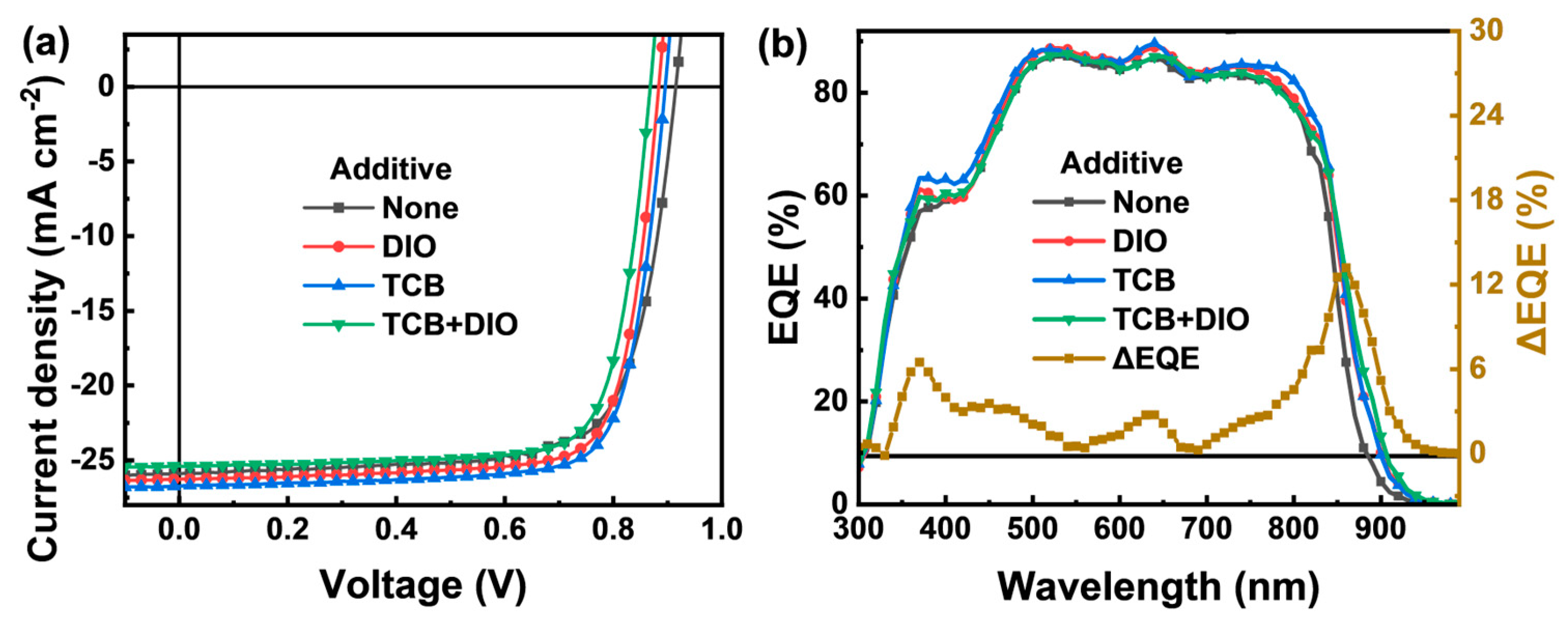
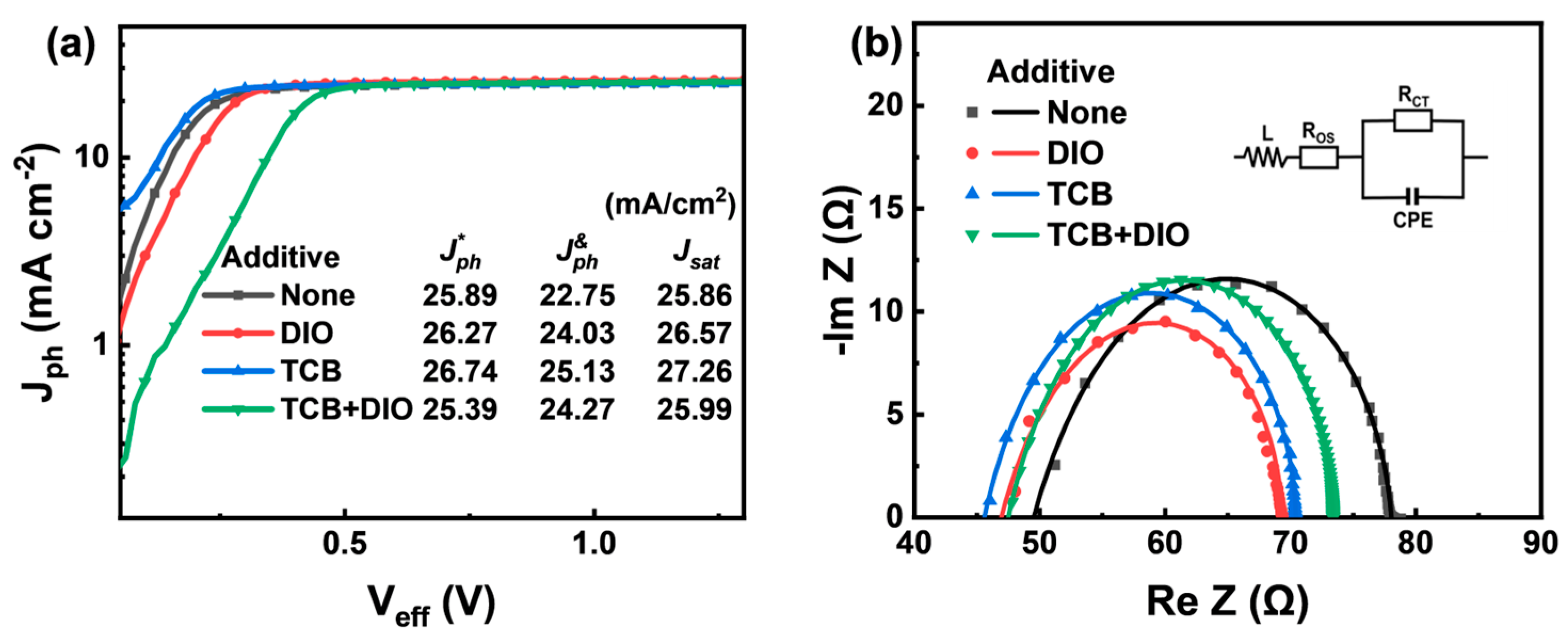
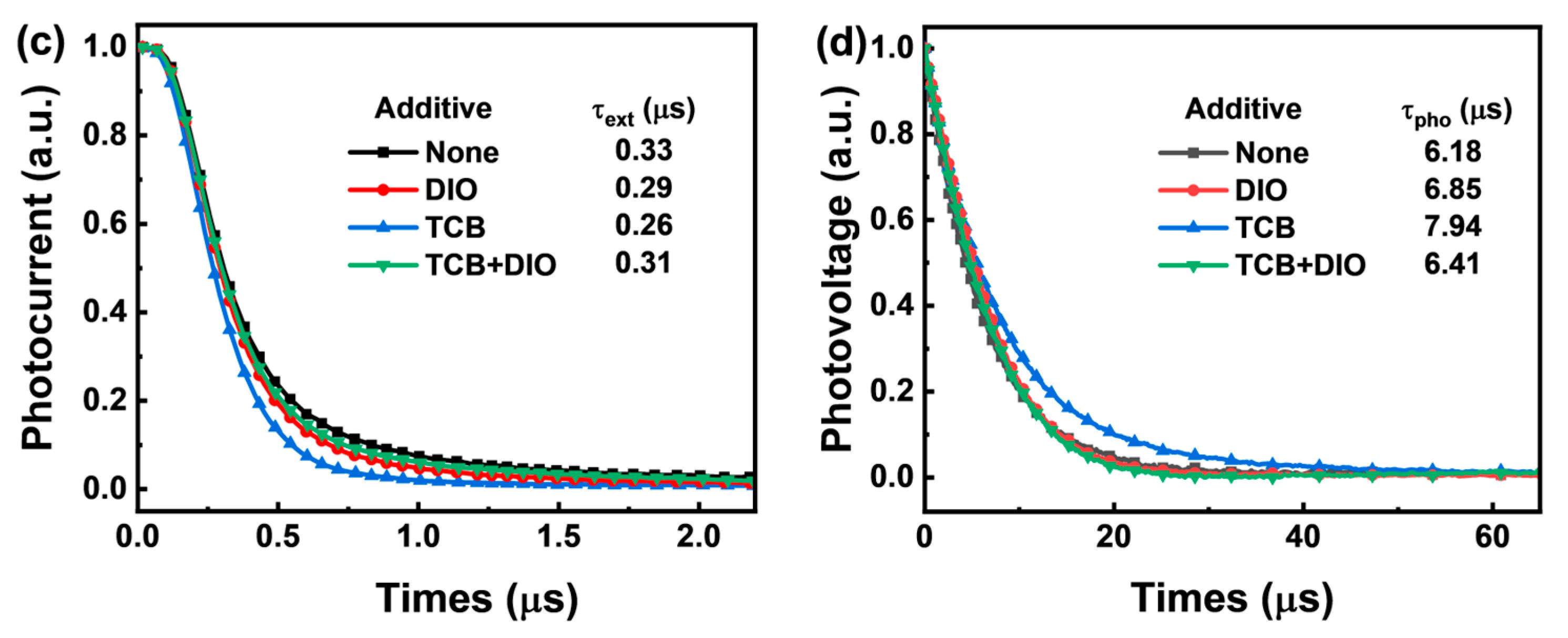
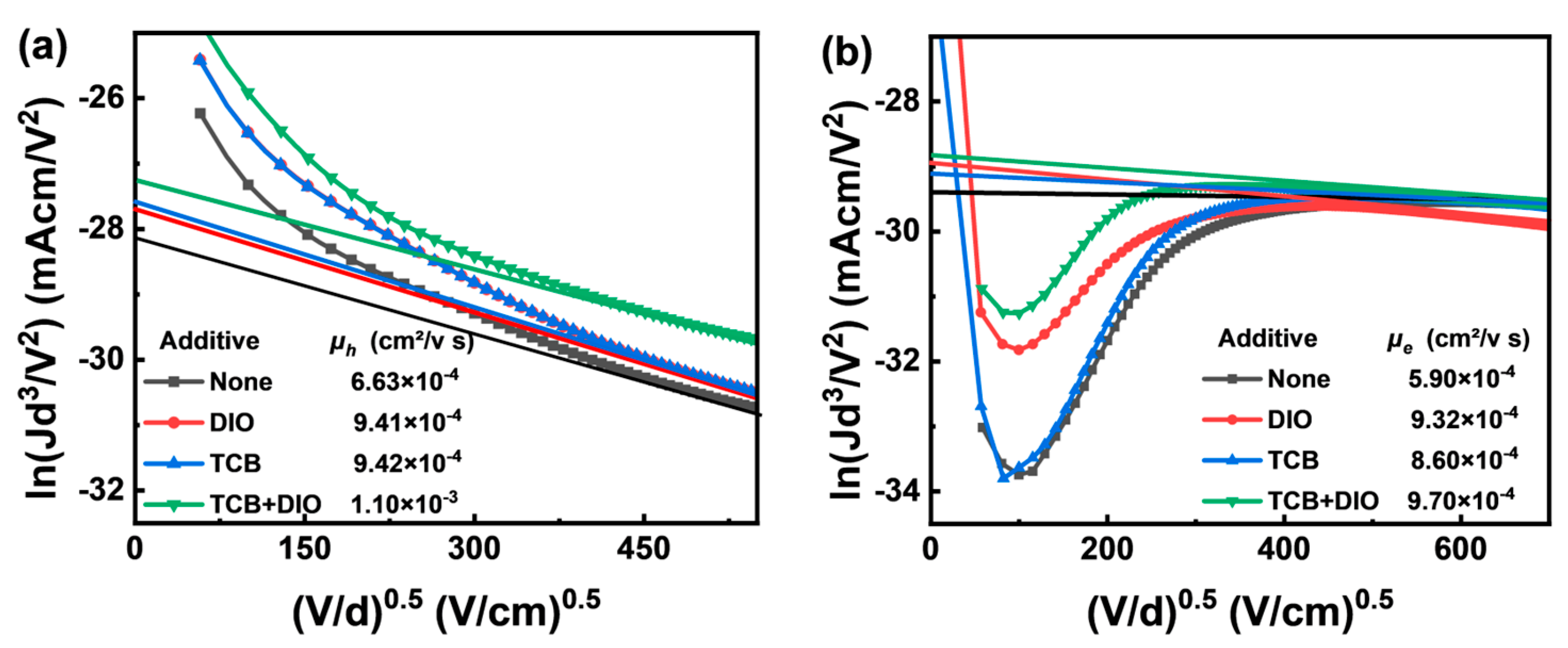
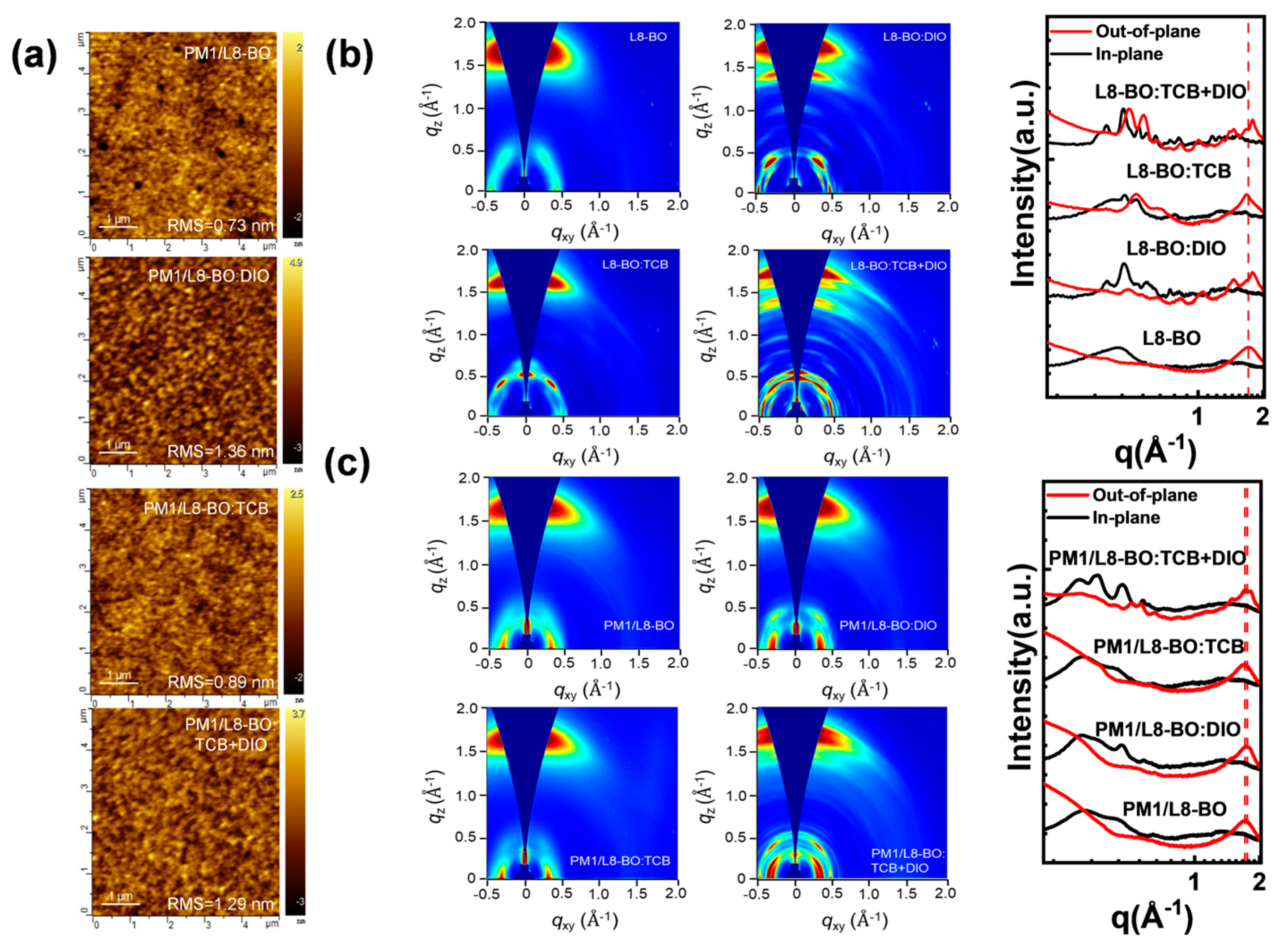
| Additive | JSC (Ave. ± Dev.) a (mA/cm2) | Cal. JSC (mA/cm2) | VOC (Ave. ± Dev.) a (V) | FF (Ave. ± Dev.) a (%) | PCE (Ave. ± Dev.) a (%) | RS (Ω cm2) | RSH (Ω cm2) |
|---|---|---|---|---|---|---|---|
| None | 25.89 (25.55 ± 0.34) | 24.57 | 0.92 (0.917 ± 0.005) | 73.16 (72.71 ± 0.45) | 17.43 (17.29 ± 0.14) | 2.8 | 650 |
| DIO | 26.27 (26.10 ± 0.17) | 25.18 | 0.88 (0.879 ± 0.002) | 77.77 (77.55 ± 0.22) | 17.98 (17.87 ± 0.11) | 2.4 | 1090 |
| TCB | 26.74 (26.46 ± 0.28) | 25.43 | 0.90 (0.898 ± 0.004) | 76.88 (76.45 ± 0.43) | 18.50 (18.38 ± 0.12) | 2.5 | 910 |
| TCB + DIO | 25.39 (25.14 ± 0.25) | 25.05 | 0.88 (0.875 ± 0.006) | 77.21 (76.83 ± 0.38) | 17.06 (16.93 ± 0.13) | 2.7 | 770 |
Disclaimer/Publisher’s Note: The statements, opinions and data contained in all publications are solely those of the individual author(s) and contributor(s) and not of MDPI and/or the editor(s). MDPI and/or the editor(s) disclaim responsibility for any injury to people or property resulting from any ideas, methods, instructions or products referred to in the content. |
© 2024 by the authors. Licensee MDPI, Basel, Switzerland. This article is an open access article distributed under the terms and conditions of the Creative Commons Attribution (CC BY) license (https://creativecommons.org/licenses/by/4.0/).
Share and Cite
Ni, Y.; Tian, H.; Gong, R.; Zhou, H.; Xu, W.; Wang, J.; Ma, X.; Zhang, F. Highly Efficient Layer-by-Layer Organic Photovoltaics Enabled by Additive Strategy. Energies 2024, 17, 4022. https://doi.org/10.3390/en17164022
Ni Y, Tian H, Gong R, Zhou H, Xu W, Wang J, Ma X, Zhang F. Highly Efficient Layer-by-Layer Organic Photovoltaics Enabled by Additive Strategy. Energies. 2024; 17(16):4022. https://doi.org/10.3390/en17164022
Chicago/Turabian StyleNi, Yuheng, Hongyue Tian, Ruifeng Gong, Hang Zhou, Wenjing Xu, Jian Wang, Xiaoling Ma, and Fujun Zhang. 2024. "Highly Efficient Layer-by-Layer Organic Photovoltaics Enabled by Additive Strategy" Energies 17, no. 16: 4022. https://doi.org/10.3390/en17164022





